Bullet Basics 1- Materials
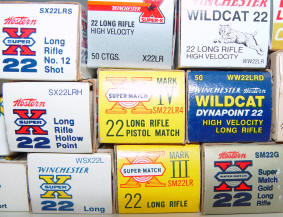
Identifying
the manufacturer and caliber of a submitted bullet is an
important examination conducted in a forensic laboratory by
Firearm and Toolmark Examiners. We've discussed the
term "caliber" on a previous page that can be found
here.
There are a number of good reasons to
determine who made the bullet but one that stands out to be of particular
importance occurs when the bullet cannot be identified to a specific firearm
through normal firearm identification techniques. Let's say that several
shots are fired at a crime scene and all of the shooters are firing GLOCK brand
9mm Luger caliber pistols. In this situation all of the bullets collected
will have the same diameter and will have the same general rifling
characteristics.
The only way in this situation to determine
who may have fired one bullet vs. another is to look at the brand of ammunition
that each shooter was using (hopefully they used different brands!) and then try
to match the physical characteristics and materials to those used by one brand
cartridge or the other.
 The fired cartridge cases collected at the
scene have headstamps that will identify who made the cartridge case, so once
they are identified to the gun they were fired from, we can look at the bullets
to see if they are similar to bullets made by those manufacturers. The fired cartridge cases collected at the
scene have headstamps that will identify who made the cartridge case, so once
they are identified to the gun they were fired from, we can look at the bullets
to see if they are similar to bullets made by those manufacturers.
By identifying the bullet manufacturer we can
now determine which gun most likely fired those bullets given the limited
universe of this one crime scene. Firearm examiners will examine the
unknown bullets and compare the physical properties of the bullets to known
standards. Through this process of direct comparison often times the
manufacturer can be determined and in doing so provide the investigation just
one more clue to help bring the case to a desirable outcome.
There are several things that firearm
examiners look for when they examine the bullets. The diameter and weight
are helpful in determining caliber, but the materials used and the
general shape of the bullet can assist in determining the manufacturer of
the unknown bullet.
Let's start with the materials used in
the manufacture of bullets.
Bullet Materials
Projectiles in general have come along way
over the last several centuries. What started out as crude rocks and
pebbles have steadily evolved into bullets born from very advanced engineering.
For some good information on the history of the bullet visit the
Wikipedia.
It wasn't until the late 15th century that
bullets were starting to be produced by casting metal into balls using molds.
The modern bullet can be manufactured through casting, swaging, milling, plating,
stamping or compression processes. Bullets are usually made of a single metal alloy or a layered combination of various materials to
include lead, copper, brass, bronze, steel, and aluminum. These layered
bullets are referred to as jacketed
bullets. The materials used in the manufacture of a bullet effect its
performance both in flight and when they reach their target.
There are two very important things that
manufacturers constantly try to strike a balance between. They are
penetration and expansion. The type of target you are shooting at dictates
the type of bullet you will use. If a bullet fails to penetrate deep
enough it may not reach the internal organs of the target and therefore not
immobilize or kill the target. Too much penetration and the bullet can
pass through the target and continue down range wasting energy.
So manufacturers are constantly trying to
design a bullet that does the best job for it's intended purpose. The
materials used in the manufacture of the bullet are very critical to achieving
the goal of the bullets impact.
Non-jacketed Bullets- The most common
material used in the manufacture of non-jacketed bullets is lead. Lead bullets
are usually an alloy of lead and antimony which is added to give the bullet some
additional hardness. Variations are the norm when it comes to the
materials used in bullets and it's not uncommon to find lead bullets with a thin
coating of copper or brass plating. Bullets having this thin coating is
sometimes referred to as a copper-washed or "Lubaloy" bullet. This thin
coating can be easily scratched away from the surface of the lead causing
problems for firearm examiners when these bullets are damaged. Another
example of a coated bullet is the Federal "Nyclad" bullet that is designed to
reduce lead emissions.
|
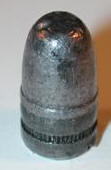 |
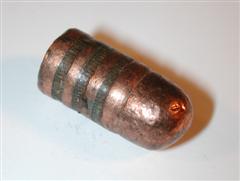 |
|
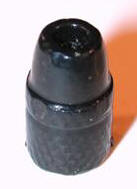 |
|
Plain Lead
Round-nosed bullet |
Copper-washed or
"Lubaloy"
lead round-nosed bullet |
|
Federal "Nyclad"
nylon coated bullet |
Other solid bullets can be machined out of a
piece of copper, brass, or similar material. Newer manufacturing
techniques use pressure to compress a material like tungsten into a bullet
referred to as a "frangible" bullet. Examples of these can be seen below.
|
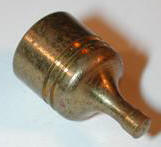 |
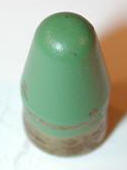 |
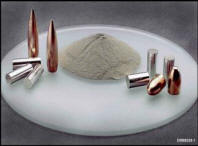 |
|
THV Solid brass
machined bullet |
KTW Teflon coated
solid brass machined bullet |
Frangible tungsten
compressed bullets |
Jacketed bullets- Jacketed bullets are
a laminate of material, with the harder "jacket" covering a core typically made
of lead. This jacket material differs from the thin copper plating seen on
the copper-washed bullets above. The jacket material cannot be easily
removed.
The most common bullet jacket material is
copper. These can sometimes be plated with nickel to give the bullet a
silver finish but the jacket can also be made of a number of other materials
such as aluminum or steel. Steel jackets are
widely used in bullets that originate in the European and Chinese markets.
Steel jacketed bullets are usually coated or plated to help prevent
rusting.
|
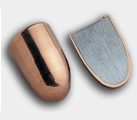 |
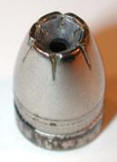 |
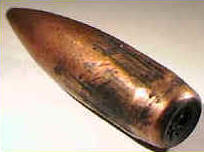 |
|
Copper jacketed
full-metal-case bullet
and cross-section |
Winchester "Silver-tip"
nickel-plated copper jacket bullet |
Copper plated
steel jacketed bullet |
Jacketed bullets usually have an opening at
the base or the nose but some are have no opening in the jacket material.
These bullets are called totally-metal-jacketed bullets (TMJ) or encapsulated
bullets.
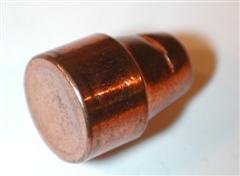
CCI totally-metal-jacketed bullet
The most common jacketed bullet core material
is lead but exceptions again exist and a common example is the 7.62x39mm armor
piercing bullet (show above right). This bullet has a steel jacket over a thin
layer of lead which surrounds a steel core. It is not uncommon for firearm
examiners to receive just the steel core as an exhibit. When this bullet
strikes a target the steel core can punch right through the nose of the jacket
material. I had a case several years ago where several of these bullets
were fired through the windshield of a car, killing the lone occupant. All
that was recovered from the victim were several steel bullet cores like those seen below.
|
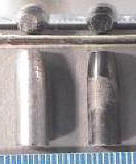 |
|
Steel cores from
7.62x39mm
steel jacketed bullets |
Jacketed bullets may also contain something
other than a lead or steel core. Some may contain small lead
pellets, plastic, or maybe even a silicone rubber material as seen below.
|
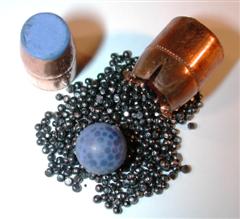 |
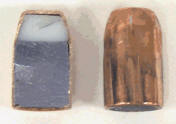
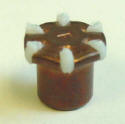
Federal Expanding Full-Metal-Jacketed (EFMJ)
bullet with silicone nose material |
|
Glaser Safety Slug
containing
small lead pellets and a plastic plug |
|
Another somewhat unusual jacketed bullet is
the Remington Accelerator. This centerfire rifle bullet consists of a
copper jacketed bullet that is of a smaller caliber than the rifle it is fired
in. This smaller bullet is surrounded by what is called a Sabot.
The sabot actually rides down the rifling of the barrel and once leaving the
barrel of the rifle the sabot and the bullet separate. The sabot falls to
the ground fairly close to the rifle but the light weighted bullet travels down
range at a high velocity minus any identifiable rifling characteristics.
They are on the sabot!
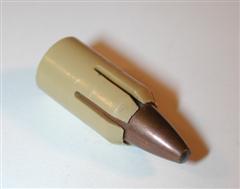
Remington Accelerator "sabot" enclosed bullet
So as you can see the materials used in
bullets can vary widely. Just remember that the above examples are a mere
drop in the bucket. I have just briefly mentioned centerfire rifle bullets
primarily because I don't receive many in casework. Handgun centerfire and
rimfire bullets are by far the most common projectiles seen in most forensic
laboratories.
Now let's discus the shape of
bullets.
Next
|